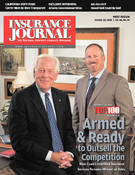Being the sixth-largest state in the nation, and one of the fastest-growing, makes Arizona an attractive place to live and do business. And that means the state is desirable from an insurance perspective, too, according to Christina Urias, the state’s Insurance Commissioner. Case in point, the homeowners and auto insurance market are competitive, the workers’ compensation insurance market is stable, and the captive market is growing, she said.
Of course, being an oasis does not mean the state is a Shangri-la. While the area’s desert climate and pine forests in the mountains make for popular tourists excursions, that environment also means the state is susceptible to wildfires. Additionally, the state shares a 389-mile border with Mexico, which creates cross-border trucking insurance issues. And, the state faces economic challenges like the rest of the nation, such as feeling the fallout of the AIG bail-out.
In the following excerpts from an interview with Insurance Journal‘s Ken St. Onge at the recent National Association of Insurance Commissioners meeting in National Harbor, Md., Urias talked about how she’s committed to helping Arizona deal with the challenges and plans to continue being a leading example for the nation. Here’s what she had to say.
Tell me a little bit about AIG and what impact its problems will have in Arizona.
Christina Urias: The problem is two-fold; it’s consumer-oriented in both senses. For policyholders, their policies are protected. The insurance companies under AIG are solvent. Arizona has two AIG subsidiary companies — life insurance companies — and I want those policyholders to know that those companies are solvent. The money is there to pay those claims. The problems with AIG arose in its other holdings, its financial institutions and other trade deals, credit defaults, swaps and that sort of thing.
We are monitoring the situation very, very closely, and if a consumer is approached to change his or her policy or sell or purchase a different one, there’s going to be surrender charges attached to that. If consumers are approached in that way, I would ask them to call the Arizona Department of Insurance, get information about the particular (offer) that they’ve received to make sure it’s legitimate, to make sure it’s appropriate for their needs.
Was the $85 billion dollar loan to the company the right decision, and what kind of impact is that going to have on the debate about state versus federal regulation of insurance?
Urias: That’s been the discussion here at the NAIC meetings. I think at first the $85 billion reassured the capital markets and reassured the policyholders. You can tell by the Dow Jones and how it went up and went back down and it went back up again. It’s important. We had a meeting with (AIG CEO) Mr. (Edward) Liddy, and he conveyed his plans, his confidence in how he’s going to proceed. It’s going to be a partnership with the insurance commissions of the 50 states. We still have state regulation over the insurance companies under the AIG umbrella, and we’re going to work with Mr. Liddy in terms of how he’s going to handle the transition, what assets will be sold, what will be retained. It speaks well of state regulation in that the most valuable assets of AIG are the insurance companies that are regulated by the states.
What should agents be aware of in the wake of problems with AIG?
Urias: Insurance departments like mine are going to look closely at what agents and brokers are doing (such as) not turning or changing over a certain annuity policy that an individual has with AIG because there are surrender charges attached to that and that could be dangerous for that consumer; it may not be appropriate.
We want to make sure that agents and brokers are treating consumers fairly, giving them full information and transparency. If there’s a necessity to change someone’s policy or to switch an annuity policy, if that’s appropriate for the situation, that’s fine. But if it’s not, then we’re going to look right at it. Again, I encourage consumers to call the Department of Insurance to get their questions answered.
What impact are workers’ compensation regulatory reforms that recently passed in your state going to have?
Urias: In the legislative session last year, Arizona increased the benefits to workers, to injured workers, in terms of their monthly indemnity coverage and what benefits they could get if they were injured on the job. Arizona has a very strong workers’ compensation market. The state compensation fund has a very large percentage of the market. We’re stable. The rates are one of the lowest in the country in terms of what employers have to pay for workers’ comp coverage.
What about other lines of property/casualty insurance?
Urias: Pretty good, In fact, the competition in the auto and homeowners markets are very, very competitive. The department publishes twice a year a premium comparison survey in the auto market and in the homeowners market. We take some hypothetical situations and look at the top 25 (carriers) and see where the prices are. This information is available to consumers on the DOI Web site as well in hard copy. If you shop around, you can see where the competition is, and you can see that the market is very healthy.
Wildfires can be a problem in Arizona, although you haven’t had any recently. How will this affect rates down the line?
Urias: Every state in our country is exposed to some natural catastrophe, and Arizona is no different with the wildfire exposure that we have. As you say, we’ve been very fortunate. The last fire was back in 2003, and that destroyed more than 300 homes in Arizona. So, the consumers that live in those fire-prone areas are very, very cognizant of what their exposures are. We, the department, publish a notice on wildfire season. We encourage the consumers to prepare a defensible area around their home and take whatever steps they can to protect it from those types of losses. But I do support a program of a national catastrophe plan to help do some pre-event funding and planning for those types of catastrophes.
Tell me a little bit about the recent captive insurance reforms in Arizona and what impacts they’re having.
Urias: The captive market in Arizona is very healthy and strong. The captive law was first initiated in 2002. I took office in 2003, and we now have 108 licensed captives doing business in Arizona and throughout the country. I have a team of financial analysts dedicated (to this) yet (they) share analytic skills with the traditional insurers. So, we do have some crossover in our department, which gives us a really good perspective on the regulatory controls over the captives.
We’re very fortunate to have some very high-quality captive insurers that are licensed in our state. For a state that’s been in the captive business for about five years or so, the growth is tremendous and I’m very pleased with the quality and the quantity that we have.
Arizona is a border state. Can you give us an update on developments in terms of insuring cross-border traffic?
Urias: I’ve joined the (International Insurance Relations) committee within the National Association of Insurance Commissioners the past couple of years. (Cross-border trucking from Mexico) is a very, very heavy industry (and there are many) insurance issues with the Mexican trucking companies and their drivers. Last March, I attended and actually chaired the NAFTA meeting in Mexico City, and we were pleased with some progress with the new regime in Mexico in terms of information sharing on the drivers and the accident history of the particular trucking companies.
The Department of Transportation, federal department, has extended the pilot program to allow more Mexican truckers into the country under this pilot program (See page 20 of Insurance Journal-West Region’s Sept. 1, 2008, issue for related story.) My concern is to get the Arizona and the U.S. insurers interested in insuring those trucking entities. But we have got to make sure that they have the data and the information that’s accurate and complete on those Mexican truckers and accidents. So, with this increased cooperation with the Mexican government, I think that’s going to happen.
Do you have any changes or processes you’d like to reform inside your own department, and what kinds of changes could we expect the next year?
Urias: Well, study as you go. We are struggling just like many, many state governments with budget constraints and a hiring freeze right now in Arizona. So, we are doing more with less. What I’m looking forward to is a turnaround in the economy. Arizona, being a leader and a fast-growing state like we are, that will allow us to expand some of the things that we do well and do them better — increase the staff, increase the number of companies doing business in our state across all lines.
Topics Catastrophe Carriers Agencies Legislation Wildfire Workers' Compensation Trucking AIG
Was this article valuable?
Here are more articles you may enjoy.


 Alliant Latest to Sue Howden US Over Alleged ‘Smash-and-Grab’ Poaching
Alliant Latest to Sue Howden US Over Alleged ‘Smash-and-Grab’ Poaching  Expense Ratio Analysis: AI, Remote Work Drive Better P/C Insurer Results
Expense Ratio Analysis: AI, Remote Work Drive Better P/C Insurer Results  DoorDash, Uber Cost Drivers $550 Million in Tips, NYC Says
DoorDash, Uber Cost Drivers $550 Million in Tips, NYC Says  10,000 Travelers Employees Get AI Assistants Via Anthropic Partnership
10,000 Travelers Employees Get AI Assistants Via Anthropic Partnership 


